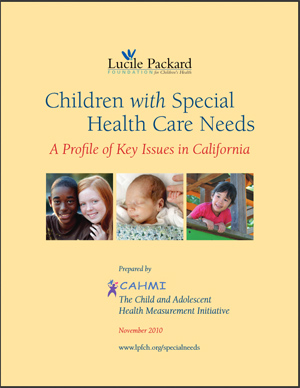Children with Special Health Care Needs: A Profile of Key Issues in California is a comprehensive report on the health and well-being of the state’s estimated 1.4 million children with special health care needs (CSHCN). This report draws on the most recently available data from the 2007 National Survey of Children’s Health and the 2005-06 National Survey of Children with Special Health Care Needs. The report provides a profile of demographic characteristics, physical, mental, and social functioning, and health and community service needs of CSHCN in California. It also summarizes key aspects of health insurance coverage, health care system performance and the impact of having a special need on school engagement, and family health and well-being for CSHCN.
The report aims to assess California CSHCN in the context of national data, highlighting variations and disparities in care between California and the rest of the nation. In making these comparisons, the report notes areas where improvement is necessary, such as enrollment for insurance coverage, availability of services, care coordination, and family and community engagement.
Throughout the report, CSHCN are defined according to the widely endorsed federal Maternal Child and Health Bureau definition which sets forth that CSHCN are those with a physical, mental, developmental, or other type of ongoing health condition that requires an above routine need for or use of health and related services of a type or amount than required by children generally.1 There is a long and compelling body of research supporting this consequences-based definition over a condition-specific, diagnostic-based definition of CSHCN.
Overall, the report, prepared by the Child and Adolescent Health Measurement Initiative under the direction of Christina Bethell, shows that California has a particularly diverse and high-need population of CSHCN, and that many families are struggling to meet the basic needs of these children. Data also show that California ranks poorly compared to other states on numerous measures of quality health care for CSHCN, including adequacy of insurance, provision of basic preventive care, and meeting minimal criteria for having a medical home (ongoing, comprehensive, coordinated, and family-centered care).

